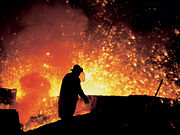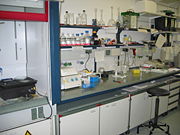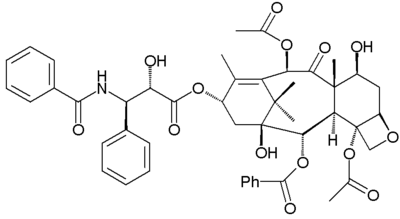Chemistry
2008/9 Schools Wikipedia Selection. Related subjects: Chemistry
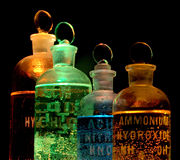
Chemistry (from Egyptian kēme (chem), meaning "earth") is the science concerned with the composition, structure, and properties of matter, as well as the changes it undergoes during chemical reactions. Historically, modern chemistry evolved out of alchemy following the chemical revolution (1773). Chemistry is a physical science related to studies of various atoms, molecules, crystals and other aggregates of matter whether in isolation or combination, which incorporates the concepts of energy and entropy in relation to the spontaneity of chemical processes.
Disciplines within chemistry are traditionally grouped by the type of matter being studied or the kind of study. These include inorganic chemistry, the study of inorganic matter; organic chemistry, the study of organic matter; biochemistry, the study of substances found in biological organisms; physical chemistry, the energy related studies of chemical systems at macro, molecular and submolecular scales; analytical chemistry, the analysis of material samples to gain an understanding of their chemical composition and structure. Many more specialized disciplines have emerged in recent years, e.g. neurochemistry the chemical study of the nervous system (see subdisciplines).
Overview
Chemistry is the scientific study of interaction of chemical substances that are constituted of atoms or the subatomic components that make up atoms: protons, electrons and neutrons. Atoms combine to produce molecules or crystals. Chemistry can be called " the central science" because it connects the other natural sciences, such as astronomy, physics, material science, biology, and geology.
The genesis of chemistry can be traced to certain practices, known as alchemy, which had been practiced for several millennia in various parts of the world, particularly the middle east.
The structure of objects we commonly use and the properties of the matter we commonly interact with, are a consequence of the properties of chemical substances and their interactions. For example, steel is harder than iron because its atoms are bound together in a more rigid crystalline lattice; wood burns or undergoes rapid oxidation because it can react spontaneously with oxygen in a chemical reaction above a certain temperature; sugar and salt dissolve in water because their molecular/ionic properties are such that dissolution is preferred under the ambient conditions.
The transformations that are studied in chemistry are a result of interaction either between different chemical substances or between matter and energy. Traditional chemistry involves study of interactions between substances in a chemistry laboratory using various forms of laboratory glassware.
A chemical reaction is a transformation of some substances into one or more other substances. It can be symbolically depicted through a chemical equation. The number of atoms on the left and the right in the equation for a chemical transformation is most often equal. The nature of chemical reactions a substance may undergo and the energy changes that may accompany it are constrained by certain basic rules, known as chemical laws.
Energy and entropy considerations are invariably important in almost all chemical studies. Chemical substances are classified in terms of their structure, phase as well as their chemical compositions. They can be analysed using the tools of chemical analysis, e.g. spectroscopy and chromatography.
Chemistry is an integral part of the science curriculum both at the high school as well as the early college level. At these levels, it is often called 'general chemistry' which is an introduction to a wide variety of fundamental concepts that enable the student to acquire tools and skills useful at the advanced levels, whereby chemistry is invariably studied in any of its various sub-disciplines. Scientists, engaged in chemical research are known as chemists. Most chemists specialize in one or more sub-disciplines.
History
The genesis of chemistry can be traced to the widely observed phenomenon of burning that led to metallurgy- the art and science of processing ores to get metals (e.g. metallurgy in ancient India). The greed for gold led to the discovery of the process for its purification, even though, the underlying principles were not well understood -- it was thought to be a transformation rather than purification. Many scholars in those days thought it reasonable to believe that there exist means for transforming cheaper (base) metals into gold. This gave way to alchemy, and the search for the Philosopher's Stone, which was believed to bring about such a transformation by mere touch.
Some consider medieval Muslims to be the earliest chemists, who introduced precise observation and controlled experimentation into the field, and discovered numerous chemical substances. The most influential Muslim chemists were Geber (d. 815), al-Kindi (d. 873), al-Razi (d. 925), and al-Biruni (d. 1048). The works of Geber became more widely known in Europe through Latin translations by a pseudo-Geber in 14th century Spain, who also wrote some of his own books under the pen name "Geber". The contribution of Indian alchemists and metallurgists in the development of chemistry was also quite significant.
The emergence of chemistry in Europe was primarily due to the recurrent incidence of the plague and blights there during the so called Dark Ages. This gave rise to a need for medicines. It was thought that there exists a universal medicine called the Elixir of Life that can cure all diseases, but like the Philosopher's Stone, it was never found.
For some practitioners, alchemy was an intellectual pursuit, over time, they got better at it. Paracelsus (1493-1541), for example, rejected the 4-elemental theory and with only a vague understanding of his chemicals and medicines, formed a hybrid of alchemy and science in what was to be called iatrochemistry. Similarly, the influences of philosophers such as Sir Francis Bacon (1561-1626) and René Descartes (1596-1650), who demanded more rigor in mathematics and in removing bias from scientific observations, led to a scientific revolution. In chemistry, this began with Robert Boyle (1627-1691), who came up with an equations known as the Boyle's Law about the characteristics of gaseous state. Chemistry indeed came of age when Antoine Lavoisier (1743-1794), developed the theory of Conservation of mass in 1783; and the development of the Atomic Theory by John Dalton around 1800. The Law of Conservation of Mass resulted in the reformulation of chemistry based on this law and the oxygen theory of combustion, which was largely based on the work of Lavoisier. Lavoisier's fundamental contributions to chemistry were a result of a conscious effort to fit all experiments into the framework of a single theory. He established the consistent use of the chemical balance, used oxygen to overthrow the phlogiston theory, and developed a new system of chemical nomenclature and made contribution to the modern metric system. Lavoisier also worked to translate the archaic and technical language of chemistry into something that could be easily understood by the largely uneducated masses, leading to an increased public interest in chemistry. All these advances in chemistry led to what is usually called the chemical revolution. The contributions of Lavoisier led to what is now called modern chemistry - the chemistry that is studied in educational institutions all over the world. It is because of these and other contributions that Antoine Lavoisier is often celebrated as the " Father of Modern Chemistry". The later discovery of Friedrich Wöhler that many natural substances, organic compounds, can indeed be synthesized in a chemistry laboratory also helped the modern chemistry to mature from its infancy.
The discoveries of the chemical elements has a long history from the days of alchemy and culminating in the creation of the periodic table of the chemical elements by Dmitri Mendeleev (1834-1907) and later discoveries of some synthetic elements.
Etymology
The word chemistry comes from the earlier study of alchemy, which is basically the quest to make gold from earthen starting materials. As to the origin of the word "alchemy" the question is a debatable one; it certainly can be traced back to the Greeks, and some, following E. Wallis Budge, have also asserted Egyptian origins. Alchemy, generally, derives from the old French alkemie from the Arabic al-kimia - "the art of transformation". The Arabs borrowed the word "kimia" from the Greeks when they conquered Alexandria in the year 642 AD. A tentative outline is as follows:
- Egyptian alchemy [3,000 BCE – 400 BCE], formulate early "element" theories such as the Ogdoad.
- Greek alchemy [332 BCE – 642 CE], the Greek king Alexander the Great conquers Egypt and founds Alexandria, having the world's largest library, where scholars and wise men gather to study.
- Arabian alchemy [642 CE – 1200], the Arabs take over Alexandria; Jabir is the main chemist
- European alchemy [1300 – present], Pseudo-Geber builds on Arabic chemistry
- Chemistry [1661], Boyle writes his classic chemistry text The Sceptical Chymist
- Chemistry [1787], Lavoisier writes his classic Elements of Chemistry
- Chemistry [1803], Dalton publishes his Atomic Theory
Thus, an alchemist was called a 'chemist' in popular speech, and later the suffix "-ry" was added to this to describe the art of the chemist as "chemistry".
Definitions
In retrospect, the definition of chemistry seems to invariably change per decade, as new discoveries and theories add to the functionality of the science. Shown below are some of the standard definitions used by various noted chemists:
- Alchemy (330) – the study of the composition of waters, movement, growth, embodying, disembodying, drawing the spirits from bodies and bonding the spirits within bodies ( Zosimos).
- Chymistry (1661) – the subject of the material principles of mixt bodies (Boyle).
- Chymistry (1663) – a scientific art, by which one learns to dissolve bodies, and draw from them the different substances on their composition, and how to unite them again, and exalt them to an higher perfection ( Glaser).
- Chemistry (1730) – the art of resolving mixt, compound, or aggregate bodies into their principles; and of composing such bodies from those principles ( Stahl).
- Chemistry (1837) – the science concerned with the laws and effects of molecular forces ( Dumas).
- Chemistry (1947) – the science of substances: their structure, their properties, and the reactions that change them into other substances (Pauling).
- Chemistry (1998) – the study of matter and the changes it undergoes ( Chang).
Basic concepts
Several concepts are essential for the study of chemistry, some of them are:
Atom
An atom is the basic unit of an element. It is a collection of matter consisting of a positively charged core (the atomic nucleus) which contains protons and neutrons, and which maintains a number of electrons to balance the positive charge in the nucleus. The atom is also the smallest entity that can be envisaged to retain some of the chemical properties of the element, such as electronegativity, ionization potential, preferred oxidation state(s), coordination number, and preferred types of bonds to form (e.g., metallic, ionic, covalent).
Element
The concept of chemical element is related to that of chemical substance. A chemical element is characterized by a particular number of protons in the nuclei of its atoms. This number is known as the atomic number of the element. For example, all atoms with 6 protons in their nuclei are atoms of the chemical element carbon, and all atoms with 92 protons in their nuclei are atoms of the element uranium. However, several isotopes of an element, that differ from one another in the number of neutrons present in the nucleus, may exist.
The most convenient presentation of the chemical elements is in the periodic table of the chemical elements, which groups elements by atomic number. Due to its ingenious arrangement, groups, or columns, and periods, or rows, of elements in the table either share several chemical properties, or follow a certain trend in characteristics such as atomic radius, electronegativity, etc. Lists of the elements by name, by symbol, and by atomic number are also available.
Compound
A compound is a substance with a particular ratio of atoms of particular chemical elements which determines its composition, and a particular organization which determines chemical properties. For example, water is a compound containing hydrogen and oxygen in the ratio of two to one, with the oxygen between the hydrogens, and an angle of 104.5° between them. Compounds are formed and interconverted by chemical reactions.
Substance
A chemical substance is a kind of matter with a definite composition and set of properties. Strictly speaking, a mixture of compounds, elements or compounds and elements is not a chemical substance, but it may be called a chemical. Most of the substances we encounter in our daily life are some kind of mixture, e.g. air, alloys, biomass etc.
Nomenclature of substances is a critical part of the language of chemistry. Generally it refers to a system for naming chemical compounds. Earlier in the history of chemistry substances were given name by their discoverer, which often led to some confusion and difficulty. However, today the IUPAC system of chemical nomenclature allows chemists to specify by name specific compounds amongst the infinite variety of possible chemicals. The standard nomenclature of chemical substances is set by the International Union of Pure and Applied Chemistry (IUPAC). There are well-defined systems in place for naming chemical species. Organic compounds are named according to the organic nomenclature system. Inorganic compounds are named according to the inorganic nomenclature system. In addition the Chemical Abstracts Service has devised a method to index chemical substance. In this scheme each chemical substance is identifiable by a numeric number known as CAS registry number.
Molecule
A molecule is the smallest indivisible portion, beside an atom, of a pure chemical substance that has its unique set of chemical properties, that is, its potential to undergo a certain set of chemical reactions with other substances. Molecules can exist as electrically neutral units unlike ions. Molecules are typically a set of atoms bound together by covalent bonds, such that the structure is electrically neutral and all valence electrons are paired with other electrons either in bonds or in lone pairs.
One of the main characteristic of a molecule is its geometry often called its structure. While the structure of diatomic, triatomic or tetra atomic molecules may be trivial, (linear, angular pyramidal etc.) the structure of polyatomic molecules, that are constituted of more than six atoms (of several elements) can be crucial for its chemical nature.
Mole
A mole is the amount of a substance that contains as many elementary entities (atoms, molecules or ions) as there are atoms in 0.012 kilogram (or 12 grams) of carbon-12, where the carbon-12 atoms are unbound, at rest and in their ground state. This number is known as the Avogadro constant, and is determined empirically. The currently accepted value is 6.02214179(30)×1023 mol-1 (2007 CODATA). It is much like the term "a dozen" in that it is an absolute number (having no units) and can describe any type of elementary object, although the mole's use is usually limited to measurement of subatomic, atomic, and molecular structures.
The number of moles of a substance in one liter of a solution is known as its molarity. Molarity is the common unit used to express the concentration of a solution in physical chemistry.
Ions and salts
An ion is a charged species, an atom or a molecule, that has lost or gained one or more electrons. Positively charged cations (e.g. sodium cation Na+) and negatively charged anions (e.g. chloride Cl−) can form a crystalline lattice of neutral salts (e.g. sodium chloride NaCl). Examples of polyatomic ions that do not split up during acid-base reactions are hydroxide (OH−) and phosphate (PO43−).
Ions in the gaseous phase is often known as plasma.
Phase
In addition to the specific chemical properties that distinguish different chemical classifications chemicals can exist in several phases. For the most part, the chemical classifications are independent of these bulk phase classifications; however, some more exotic phases are incompatible with certain chemical properties. A phase is a set of states of a chemical system that have similar bulk structural properties, over a range of conditions, such as pressure or temperature. Physical properties, such as density and refractive index tend to fall within values characteristic of the phase. The phase of matter is defined by the phase transition, which is when energy put into or taken out of the system goes into rearranging the structure of the system, instead of changing the bulk conditions.
Sometimes the distinction between phases can be continuous instead of having a discrete boundary, in this case the matter is considered to be in a supercritical state. When three states meet based on the conditions, it is known as a triple point and since this is invariant, it is a convenient way to define a set of conditions.
The most familiar examples of phases are solids, liquids, and gases. Many substances exhibit multiple solid phases. For example, there are three phases of solid iron (alpha, gamma, and delta) that vary based on temperature and pressure. A principal difference between solid phases is the crystal structure, or arrangement, of the atoms. Less familiar phases include plasmas, Bose-Einstein condensates and fermionic condensates and the paramagnetic and ferromagnetic phases of magnetic materials. While most familiar phases deal with three-dimensional systems, it is also possible to define analogs in two-dimensional systems, which has received attention for its relevance to systems in biology.
Chemical bond
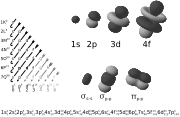
A chemical bond is a concept for understanding how atoms stick together in molecules. It may be visualized as the multipole balance between the positive charges in the nuclei and the negative charges oscillating about them. More than simple attraction and repulsion, the energies and distributions characterize the availability of an electron to bond to another atom. These potentials create the interactions which holds together atoms in molecules or crystals. In many simple compounds, Valence Bond Theory, the Valence Shell Electron Pair Repulsion model ( VSEPR), and the concept of oxidation number can be used to predict molecular structure and composition. Similarly, theories from classical physics can be used to predict many ionic structures. With more complicated compounds, such as metal complexes, valence bond theory fails and alternative approaches, primarily based on principles of quantum chemistry such as the molecular orbital theory, are necessary. See diagram on electronic orbitals.
Chemical reaction
Chemical reaction is a concept related to the transformation of a chemical substance through its interaction with another, or as a result of its interaction with some form of energy. A chemical reaction may occur naturally or carried out in a laboratory by chemists in specially designed vessels which are often laboratory glassware. It can result in the formation or dissociation of molecules, that is, molecules breaking apart to form two or more smaller molecules, or rearrangement of atoms within or across molecules. Chemical reactions usually involve the making or breaking of chemical bonds. Oxidation, reduction, dissociation, acid-base neutralization and molecular rearrangement are some of the commonly used kinds of chemical reactions.
A chemical reaction can be symbolically depicted through a chemical equation. While in a non-nuclear chemical reaction the number and kind of atoms on both sides of the equation are equal, for a nuclear reaction this holds true only for the nuclear particles viz. protons and neutrons.
The sequence of steps in which the reorganization of chemical bonds may be taking place in the course of a chemical reaction is called its mechanism. A chemical reaction can be envisioned to take place in a number of steps, each of which may have a different speed. Many reaction intermediates with variable stability can thus be envisaged during the course of a reaction. Reaction mechanisms are proposed to explain the kinetics and the relative product mix of a reaction. Many physical chemists specialize in exploring and proposing the mechanisms of various chemical reactions. Several empirical rules, like the Woodward-Hoffmann rules often come handy while proposing a mechanism for a chemical reaction.
A stricter definition is that "a chemical reaction is a process that results in the interconversion of chemical species". Under this definition, a chemical reaction may be an elementary reaction or a stepwise reaction. An additional caveat is made, in that this definition includes cases where the interconversion of conformers is experimentally observable. Such detectable chemical reactions normally involve sets of molecular entities as indicated by this definition, but it is often conceptually convenient to use the term also for changes involving single molecular entities (i.e. 'microscopic chemical events').
Energy
A chemical reaction is invariably accompanied by an increase or decrease of energy of the substances involved. Some energy is transferred between the surroundings and the reactants of the reaction in the form of heat or light, thus the products of a reaction may have more or less energy than the reactants. A reaction is said to be exothermic if the final state is lower on the energy scale than the initial state; in case of endothermic reactions the situation is otherwise.
Chemical reactions are invariably not possible unless the reactants surmount an energy barrier known as the activation energy. The speed of a chemical reaction (at given temperature T) is related to the activation energy E, by the Boltzmann's population factor e − E / kT - that is the probability of molecule to have energy greater than or equal to E at the given temperature T. This exponential dependence of a reaction rate on temperature is known as the Arrhenius equation. The activation energy necessary for a chemical reaction can be in the form of heat, light, electricity or mechanical force in the form of ultrasound.
A related concept free energy, which incorporates entropy considerations too, is a very useful means for predicting the feasibility of a reaction and determining the state of equilibrium of a chemical reaction, in chemical thermodynamics. A reaction is feasible only if the total change in the Gibbs free energy is negative,  ; if it is equal to zero the chemical reaction is said to be at equilibrium.
; if it is equal to zero the chemical reaction is said to be at equilibrium.
There are only a limited possible states of energy for electrons, atoms and molecules. These are determined by the rules of quantum mechanics, which require quantization of energy of a bound system. The atoms/molecules in an higher energy state are said to be excited. The molecules/atoms of substance in an excited energy state are often much more reactive, that is amenable to chemical reactions.
The phase of a substance is invariably determined by its energy and those of its surroundings. When the intermolecular forces of a substance are such that energy of the surroundings is not sufficient to overcome them, it occurs in a more ordered phase like liquid or solid as is the case with water (H2O), a liquid at room temperature because its molecules are bound by hydrogen bonds. Whereas hydrogen sulfide (H2S) is a gas at room temperature and standard pressure, as its molecules are bound by weaker dipole-dipole interactions.
The transfer of energy from one chemical substance to other depend on the size of energy quanta emitted from one substance. However, heat energy is easily transferred from almost any substance to another mainly because the vibrational and rotational energy levels in a substance are very closely placed. Because, the electronic energy levels are not so closely spaced, ultraviolet electromagnetic radiation is not transferred with equal felicity, as is also the case with electrical energy.
The existence of characteristic energy levels for different chemical substances is useful for their identification by the analysis of spectral lines of different kinds of spectra often used in chemical spectroscopy e.g. IR, microwave, NMR, ESR etc. This is used to identify the composition of remote objects - like stars and far galaxies - by analyzing their radiation (see spectroscopy).

The term chemical energy is often used to indicate the potential of a chemical substance to undergo a transformation through a chemical reaction or transform other chemical substances.
Chemical laws
Chemical reactions are governed by certain laws, which have become fundamental concepts in chemistry. Some of them are:
- Law of conservation of mass, according to the modern physics it is actually energy that is conserved, and that energy and mass are related; a concept which becomes important in nuclear chemistry.
- Law of conservation of Energy leads to the important concepts of equilibrium, thermodynamics, and kinetics.
- Law of definite composition, although in many systems (notably biomacromolecules and minerals) the ratios tend to require large numbers, and are frequently represented as a fraction.
- Law of multiple proportions
- Hess's Law
- Beer-Lambert law
- Fick's law of diffusion
- Raoult's Law
- Henry's law
- Boyle's law (1662, relating pressure and volume)
- Charles's law (1787, relating volume and temperature)
- Gay-Lussac's law (1809, relating pressure and temperature)
- Avogadro's law
Subdisciplines
Chemistry is typically divided into several major sub-disciplines. There are also several main cross-disciplinary and more specialized fields of chemistry.
- Analytical chemistry is the analysis of material samples to gain an understanding of their chemical composition and structure. Analytical chemistry incorporates standardized experimental methods in chemistry. These methods may be used in all subdisciplines of chemistry, excluding purely theoretical chemistry.
- Biochemistry is the study of the chemicals, chemical reactions and chemical interactions that take place in living organisms. Biochemistry and organic chemistry are closely related, as in medicinal chemistry or neurochemistry. Biochemistry is also associated with molecular biology and genetics.
- Inorganic chemistry is the study of the properties and reactions of inorganic compounds. The distinction between organic and inorganic disciplines is not absolute and there is much overlap, most importantly in the sub-discipline of organometallic chemistry.
- Materials chemistry is the preparation, characterization, and understanding of substances with a useful function. The field is a new breadth of study in graduate programs, and it integrates elements from all classical areas of chemistry with a focus on fundamental issues that are unique to materials. Primary systems of study include the chemistry of condensed phases (solids, liquids, polymers) and interfaces between different phases.
- Nuclear chemistry is the study of how subatomic particles come together and make nuclei. Modern Transmutation is a large component of nuclear chemistry, and the table of nuclides is an important result and tool for this field.
- Organic chemistry is the study of the structure, properties, composition, mechanisms, and reactions of organic compounds. An organic compound is defined as any compound based on a carbon skeleton.
- Physical chemistry is the study of the physical and fundamental basis of chemical systems and processes. In particular, the energetics and dynamics of such systems and processes are of interest to physical chemists. Important areas of study include chemical thermodynamics, chemical kinetics, electrochemistry, statistical mechanics, and spectroscopy. Physical chemistry has large overlap with molecular physics. Physical chemistry involves the use of calculus in deriving equations. It is usually associated with quantum chemistry and theoretical chemistry. Physical chemistry is a distinct discipline from chemical physics.
- Theoretical chemistry is the study of chemistry via fundamental theoretical reasoning (usually within mathematics or physics). In particular the application of quantum mechanics to chemistry is called quantum chemistry. Since the end of the Second World War, the development of computers has allowed a systematic development of computational chemistry, which is the art of developing and applying computer programs for solving chemical problems. Theoretical chemistry has large overlap with (theoretical and experimental) condensed matter physics and molecular physics.
Other fields include Astrochemistry, Atmospheric chemistry, Chemical Engineering, Chemical biology, Chemo-informatics, Electrochemistry, Environmental chemistry, Flow chemistry, Geochemistry, Green chemistry, History of chemistry, Materials science, Mathematical chemistry, Medicinal chemistry, Molecular Biology, Nanotechnology, Oenology, Organometallic chemistry, Petrochemistry, Pharmacology, Photochemistry, Phytochemistry, Polymer chemistry, Solid-state chemistry, Sonochemistry, Supramolecular chemistry, Surface chemistry, Immunochemistry and Thermochemistry.
Chemical industry
The chemical industry represents an important economic activity. The global top 50 chemical producers in 2004 had sales of 587 billion US dollars with a profit margin of 8.1% and research and development spending of 2.1% of total chemical sales.
Professional societies
- American Chemical Society
- Chemical Institute of Canada
- Chemical Society of Peru
- International Union of Pure and Applied Chemistry
- Royal Australian Chemical Institute
- Royal Society of Chemistry
- Society of Chemical Industry
- World Association of Theoretical and Computational Chemists
